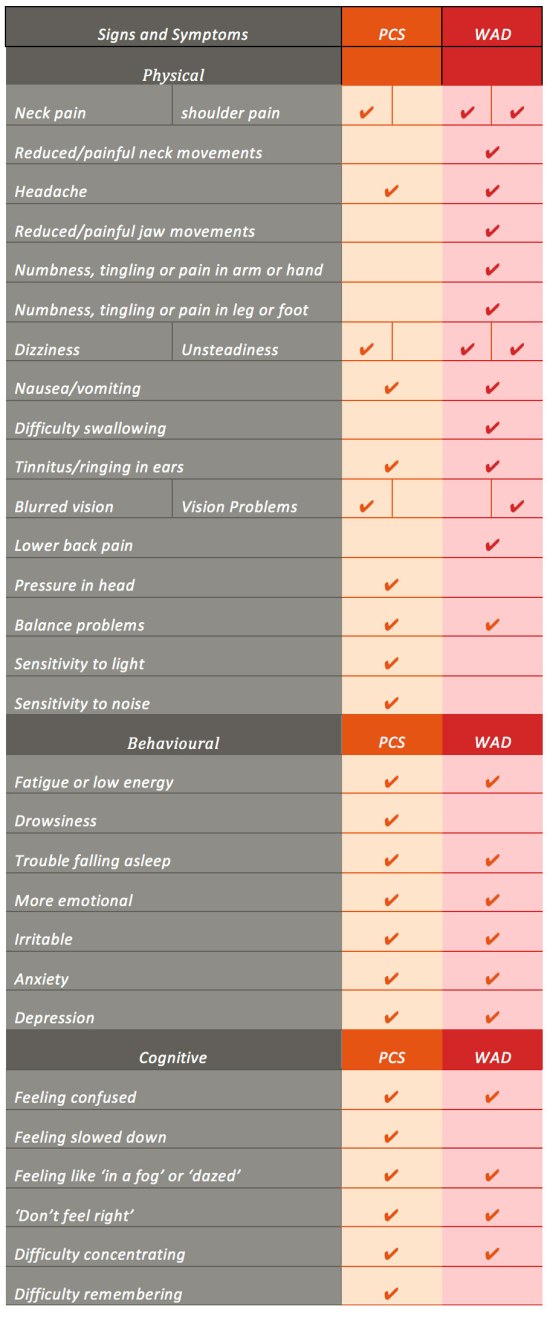I’ve been sifting through the concussion and whiplash evidence for a good 4-5 months now and quite frankly it is complex. I understand the challenges the evidence demonstrates in determining the diagnostic nuances between each. For example, there are many symptoms that overlap between concussion and whiplash (Elkin, Elliott, & Siegmund, 2016; Rebbeck, Evans, & Elliott, 2019; Sharp & Jenkins, 2015). MVA and sports related concussion (SRC) are said to be the two leading causes of injury and symptoms related to concussion and whiplash (Mullally, 2017). According to Elkin et al., (2016)the biomechanics related to MVA and SRC are unclear. The authors identify that whilst rear end crashes have a high risk of whiplash there is also the risk of an impact injury to the head from the head restraint resulting in a concussion. Similarly in SRC there are often reaction forces in the neck due to head impacts. Interestingly, the forces required for a whiplash to occur is around 4.5g (g = gravity) compared to that of a concussion which is around 60-160g (C. M. Marshall, Vernon, Leddy, & Baldwin, 2015). So, it’s highly likely that when you have a concussion you will sustain a whiplash type injury. What’s even more interesting is that much of the literature states that most concussion resolves within standard healing times frames, around 3 months (Ellis, Leddy, & Willer, 2015; Leddy, Sandhu, Sodhi, Baker, & Willer, 2012; C. M. Marshall et al., 2015)as is also the case for whiplash (Ritchie & Sterling, 2016). So with symptom overlap, indistinguishable mechanisms of injury, resolution of both conditions within a 3 month time frame, this raises a series of questions.
- Which condition are we treating? Does it matter? Do we need to treat them separately?
- What treatments are we using to manage these conditions? Are they effective?
- How do psychosocial factors, the impact of central sensitization and changes in neuroimmune function contribute to the perpetuation of these two conditions?
- Are there any clinical predictors for concussion or whiplash?”
So, most cases of concussion and whiplash resolve in the first 3 months following initial injury. However, a subgroup of people, around 33% for concussion (Leddy et al., 2012)and 50% for whiplash (Ritchie & Sterling, 2016)go on to have persisting symptoms.
Specifically, when symptoms of concussion persist the individual is classified as having post-concussion syndrome (PCS). There is much controversy around the label of concussion and PCS due to the lack of clarity around the definitions, diagnostic confusion and limitation of effective treatments (Sharp & Jenkins, 2015). According to the clinical criteria of the World Health Organization’s International Classification of Diseases, or ICD-10, PCS is defined as 3 or more of the following symptoms are present: headache, dizziness, fatigue, irritability, insomnia, concentration difficulty, or memory difficulty. The confusing thing is all of the above symptoms are present in whiplash (See Figure. 1). Now you might be querying memory difficulty but according to the literature it is a symptom of whiplash (Beeckmans & Michiels, 2017). What was particularly interesting reading was another study by Beeckmans et al., (2017). His team found ‘while cognitive impairment following whiplash and mTBI appear to be similar, some aspects including long-term memory, reasoning and accuracy in problem solving were worse in patients with whiplash compared with mTBI.’

Furthermore,Coppieters et al., (2015)found significant correlations between cognitive impairment, indices of central sensitization and self-reported health related quality of life in individuals with chronic whiplash.
Another interesting challenge is reconciling the nuances in classification of Traumatic Brain Injury (TBI) and concussion (Sharp & Jenkins, 2015). Whilst it may be regarded as trivial semantics, it has been proposed that concussion and mild TBI should be viewed as distinct entities as currently there is 1) no clear pathological definition to distinguish concussion from other types of TBI and 2) the mechanism of injury are often the same – a blow to the head or a result of rapid acceleration/deceleration of the head and neck resulting in the brain striking the inside of the skull. Yet, concussion is seen as benign, with no structural damage and self-resolving symptoms. Whereas TBI is argued as involving an increasing degree of structural damage with similar symptoms (see figure.2) (Sharp & Jenkins, 2015). McCrory et al., (2017) corroborate these nuances stating that, ‘Such operational definitions, however, do not give any insights into the underlying processes through which the brain is impaired, nor do they distinguish different grades of severity, nor reflect newer insights into persistence of symptoms and/or abnormalities on specific investigational modalities.’ Thus, a disagreement arises around validity of the criteria within the definitions.

Indeed, the nuance between concussion and TBI is problematic, yet what I find even more so are the nuances between concussion and whiplash associated disorders (WAD) as we can see in figure. 1.
I appreciate that the SCAT 3 has been replaced by the SCAT 5 and for good reason. The SCAT 3 requested individuals record their ‘state’ symptom experience, meaning that symptom measurement is recorded in the moment, at baseline and post-concussion evaluation. The SCAT 5 now requests that individuals record ‘trait’ symptoms at baseline, meaning how a person would typically feel. The developers of the SCAT 5 identified that individuals (because we are human and adapt to our environment negatively or positively) can have concussion-like symptoms (mood and learning factors, psychological distress etc) in the absence of concussion (Asken, Houck, Bauer, & Clugston, 2019). For example, evidence suggests that individuals with a higher disposition towards catastrophic thought, posttraumatic stress and trait anxiety are more at risk of developing post-concussion syndrome (Chaput, Lajoie, Naismith, & Lavigne, 2016; Cnossen et al., 2018; Iverson, 2019; Wijenberg, Stapert, Verbunt, Ponsford, & Van Heugten, 2017). It may not surprise you but the findings are similar for whiplash (Laporte et al., 2016; Sarrami, Armstrong, Naylor, & Harris, 2017; Williamson, Williams, Gates, & Lamb, 2015), arrrrgh!!
So it’s hard to define concussion/mTBI/PCS and whiplash because of sign and symptom overlap, diagnostic nuances, pre-injury psychosocial factors, mechanisms of injury and what additional structures may be involved. This can make diagnosis challenging and signs and symptoms can persist for months or even years after initial insult (De Kooning et al., 2015; Laporte et al., 2016; S. Marshall et al., 2015; Stulemeijer, Van Der Werf, Borm, & Vos, 2008).
There are many questions I continue to ponder on, meaning there’s lots of discussion to be had around concussion and whiplash. I think what can be said is that there are many symptoms and presentations that can coincide with these conditions and a multimodal approach is certainly warranted.
In a blog later in the year, I’ll be looking closer at the Trigeminocervical Nucleus and its branches throughout the head and neck, examine the various presentations that occur in concussion and whiplash, delve more into psychosocial factors, discuss some of the treatments currently being used for each condition and see if we can identify any additional clinical predictors.
Thanks for having a read.
TNP
References
Asken, B. M., Houck, Z. M., Bauer, R. M., & Clugston, J. R. (2019). SCAT5 vs. SCAT3 Symptom Reporting Differences and Convergent Validity in Collegiate Athletes. Archives of Clinical Neuropsychology, 2004, 1–11. https://doi.org/10.1093/arclin/acz007
Beeckmans, K., Crunelle, C., Van Ingelgom, S., Michiels, K., Dierckx, E., Vancoillie, P., … Sabbe, B. (2017). Persistent cognitive deficits after whiplash injury: a comparative study with mild traumatic brain injury patients and healthy volunteers. Acta Neurologica Belgica, 117(2), 493–500. https://doi.org/10.1007/s13760-017-0745-3
Beeckmans, K., & Michiels, K. (2017). Whiplash Injury and Mild Traumatic Brain Injury: Differential Effects on Cognitive Functioning? International Journal of Neurorehabilitation, 04(03), 12–15. https://doi.org/10.4172/2376-0281.1000271
Chaput, G., Lajoie, S. P., Naismith, L. M., & Lavigne, G. (2016). Pain catastrophizing correlates with early mild traumatic brain injury outcome. Pain Research and Management,2016. https://doi.org/10.1155/2016/2825856
Cnossen, M. C., Van Der Naalt, J., Spikman, J. M., Nieboer, D., Yue, J. K., Winkler, E. A., … Lingsma, H. F. (2018). Prediction of Persistent Post-Concussion Symptoms after Mild Traumatic Brain Injury. Journal of Neurotrauma, 35(22), 2691–2698. https://doi.org/10.1089/neu.2017.5486
Coppieters, I., Ickmans, K., Cagnie, B., Nijs, J., De Pauw, R., Noten, S., & Meeus, M. (2015). Cognitive performance is related to central sensitization and health-related quality of life in patients with chronic whiplash-associated disorders and fibromyalgia. Pain Physician, 18(3), E389–E402.
De Kooning, M., Daenen, L., Roussel, N., Cras, P., Buyl, R., Ickmans, K., … Nijs, J. (2015). Endogenous pain inhibition is unrelated to autonomic responses in acute whiplash-associated disorders. Journal of Rehabilitation Research and Development, 52(4), 431–440. https://doi.org/10.1682/JRRD.2014.06.0154
Elkin, B. S., Elliott, J. M., & Siegmund, G. P. (2016). Whiplash injury or concussion? A possible biomechanical explanation for concussion symptoms in some individuals following a rear-end collision. Journal of Orthopaedic and Sports Physical Therapy,46(10), 874–885. https://doi.org/10.2519/jospt.2016.7049
Ellis, M. J., Leddy, J. J., & Willer, B. (2015). Physiological, vestibulo-ocular and cervicogenic post-concussion disorders: An evidence-based classification system with directions for treatment. Brain Injury, 29(2), 238–248. https://doi.org/10.3109/02699052.2014.965207
Iverson, G. L. (2019). Network analysis and precision rehabilitation for the postconcussion syndrome. Frontiers in Neurology, 10(MAY), 31–40. https://doi.org/10.3389/fneur.2019.00489
Laporte, S., Wang, D., Lecompte, J., Blancho, S., Sandoz, B., Feydy, A., … Vidal, P. P. (2016). An attempt of early detection of poor outcome after whiplash. Frontiers in Neurology, 7(OCT). https://doi.org/10.3389/fneur.2016.00177
Leddy, J. J., Sandhu, H., Sodhi, V., Baker, J. G., & Willer, B. (2012). Rehabilitation of Concussion and Post-concussion Syndrome. Sports Health, 4(2), 147–154. https://doi.org/10.1177/1941738111433673
Marshall, C. M., Vernon, H., Leddy, J. J., & Baldwin, B. A. (2015). The role of the cervical spine in post-concussion syndrome. Physician and Sportsmedicine, 43(3), 274–284. https://doi.org/10.1080/00913847.2015.1064301
Marshall, S., Bayley, M., McCullagh, S., Velikonja, D., Berrigan, L., Ouchterlony, D., & Weegar, K. (2015). Updated clinical practice guidelines for concussion/mild traumatic brain injury and persistent symptoms. Brain Injury, 29(6), 688–700. https://doi.org/10.3109/02699052.2015.1004755
McCrory, P., Meeuwisse, W., Dvořák, J., Aubry, M., Bailes, J., Broglio, S., … Vos, P. E. (2017). Consensus statement on concussion in sport—the 5th international conference on concussion in sport held in Berlin, October 2016. British Journal of Sports Medicine,51(11), 838–847. https://doi.org/10.1136/bjsports-2017-097699
Mullally, W. J. (2017). Concussion. The American Journal of Medicine, 130(8), 885–892. https://doi.org/10.1016/j.amjmed.2017.04.016
Rebbeck, T., Evans, K., & Elliott, J. M. (2019). Concussion in combination with whiplash-associated disorder may be missed in primary care: Key recommendations for assessment and management. Journal of Orthopaedic & Sports Physical Therapy, 49(11), 819–828.
Ritchie, C., & Sterling, M. (2016). Recovery pathways and prognosis after whiplash injury. Journal of Orthopaedic and Sports Physical Therapy, 46(10), 851–861. https://doi.org/10.2519/jospt.2016.6918
Sarrami, P., Armstrong, E., Naylor, J. M., & Harris, I. A. (2017, March 1). Factors predicting outcome in whiplash injury: a systematic meta-review of prognostic factors. Journal of Orthopaedics and Traumatology. Springer-Verlag Italia s.r.l. https://doi.org/10.1007/s10195-016-0431-x
Sharp, D. J., & Jenkins, P. O. (2015). Concussion is confusing us all. Practical Neurology, 15(3), 172–186. https://doi.org/10.1136/practneurol-2015-001087
Stulemeijer, M., Van Der Werf, S., Borm, G. F., & Vos, P. E. (2008). Early prediction of favourable recovery 6 months after mild traumatic brain injury. Journal of Neurology, Neurosurgery and Psychiatry, 79(8), 936–942. https://doi.org/10.1136/jnnp.2007.131250
Wijenberg, M. L. M., Stapert, S. Z., Verbunt, J. A., Ponsford, J. L., & Van Heugten, C. M. (2017). Does the fear avoidance model explain persistent symptoms after traumatic brain injury? Brain Injury, 31(12), 1597–1604. https://doi.org/10.1080/02699052.2017.1366551
Williamson, E., Williams, M. A., Gates, S., & Lamb, S. E. (2015). Risk factors for chronic disability in a cohort of patients with acute whiplash associated disorders seeking physiotherapy treatment for persisting symptoms. Physiotherapy (United Kingdom), 101(1), 34–43. https://doi.org/10.1016/j.physio.2014.04.004


Leave a comment